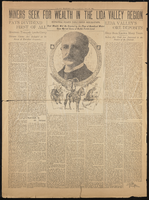Search the Special Collections and Archives Portal
Search Results

Transcript of interview with Jane Greenspun Gale by Barbara Tabach January 31 and February 9, 2018
Date
Archival Collection
Description
Jane Greenspun Gale-actor, activist, writer, magazine publisher, philanthropist, and farmer- has filled her life with accomplishments such as the Animal Foundation and Springs Preserve. It has also been a life filled with adventure - from “looking for John Lennon” during her time living and studying acting in London to learning to raise chickens on the acres of the Gilcrease Farm she owns with husband and photographer Jeff Gale. Everyone calls her Janie. Born Jane in 1949, she is the third of four children born to community leaders Barbara and Hank Greenspun. In this oral history, Janie captures the fun of growing up in Las Vegas under the watching eye of Hank. As a teen she and her friends cruised Fremont Street. Several years later she wanted to be arrested protesting the Atomic Test Site, when Hank diverted her into reporting about the event instead. Her Jewish foundation was at Temple Beth Sholom, where her parents were among the founding members. As the Jewish population grew, the tastes in synagogues grew to reflect the change. When Janie’s children preferred the Reform approach at Congregation Ner Tamid, a new family tradition began. She is proud of her background and shares loving stories of time spent with her grandparents as a child and pride in the heroic and dramatic story behind the naming of Hank Greenspun Plaza in Israel. Even her love story with Jeff is a tale made for movies. It unfolds in this engaging oral history interview along with anecdotes that are plucked from her personal history and preserve a reflection of growing up in Las Vegas, one of the Greenspun family of local fame.
Text
North Las Vegas Bicentennial Committee Photographs and Drawings of Kiel Ranch
Identifier
Abstract
The North Las Vegas Bicentennial Committee Photographs and Drawings of Kiel Ranch document the buildings on Kiel (Kyle) Ranch in 1974. As part of the commemoration of the United States bicentennial, the North Las Vegas City Council elected to restore Kiel Ranch, which was one of the first non-indigenous settlements in the Las Vegas Valley. The materials include black-and-white photographs of Kiel Ranch as it was in 1974 as well as architectural drawings of planned renovations to the main house, the Brown House, the foreman's house, and the ranch hands' house.
Archival Collection
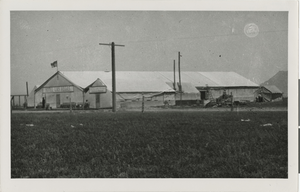
Photograph of the Hotel Las Vegas (Las Vegas), 1905
Date
Archival Collection
Description
The Hotel Las Vegas was the first hotel in Las Vegas, a tent set up for people who came to participate in the land auction. Managed by Pop Squires." Transcribed from back of photo: "Hotel Las Vegas 1905. Hotel Las Vegas, built by Las Vegas Trading Co. in 1905 was located on North Main Street between Stewart and the creek across from Woodards Down Town Camp on grounds later occupied by Elwells Ware House. All canvas and lumber used in building was cut to size and holes bored in Los Angeles, ready to be bolted together on arrival in Las Vegas. Hotel had 20 rooms. Floor space was 40 x 130 ft. Kitchen and Dining Room are seen next door to Hotel on the right. This Hotel was managed by Chas. P. Squires. Photo by Eddie Gillette, 1905." Transcribed from Special Collections sheet: "Selling of L.V. First L.V. Hotel pic cap. First Las Vegas Hotel -- The Hotel Las Vegas was made ready for the first buyers of real estate at the 1905 auction when the Las Vegas Trading Co., managed by Charles (Pop) Squires, opened the registry. All canvas and lumber used in building was cut to size and holes bored in Los Angeles, a prefab forerunner. Hotel Las Vegas boasted 20 rooms and was regarded as the top 'night spot' of its day."
Site Name: Hotel Las Vegas
Address: 1 Fremont Street
Image
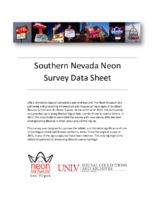
Joker's Wild Casino Neon Survey document, August 20, 2017
Date
Archival Collection
Description
Site address: 920 N Boulder Hwy
Sign owner: Boyd Gaming
Sign details: Opened 1990 as Cattle Baron Casino, closed and reopened at Joker's Wild 1993.
Sign condition: 5 - well maintained sign
Sign form: Super Pylon, and on top of building.
Sign-specific description: Neon Jester's hat on top of the Pylon sign, with a casino sign below and a reader board below that. Large neon Jester's hat on top of the Building. "Jokers Wild Casino" wrapping part of the building also in neon.
Sign - type of display: Neon
Sign - media: Steel
Sign - non-neon treatments: Reader board and LED
Sign animation: Chase with light bulbs around outside of the cabinet that houses the property name.
Sign environment: On Boulder Highway in Henderson surrounded by empty lots and small residential areas.
Sign - date of installation: c. 1993
Sign - thematic influences: The property uses the joker playing card theme. This time is used with several other casino properties throughout the Las Vegas Valley.
Survey - research locations: Boyd Gaming website, assessor's website
Surveyor: Wyatt Currie-Diamond
Survey - date completed: 2017-08-20
Sign keywords: Pylon; Neon; Steel; Chasing; Reader board; Video screen; Porte-cochère
Text
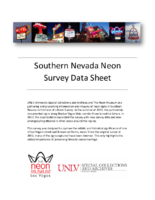
Lucky Cuss Neon Survey document, September 14, 2017
Date
Archival Collection
Description
Site address: 3305 Fremont St
Sign owner: D B N G LLC
Sign details: This property was originally the Panorama Motel, which opened in the 1950's. However, the signage later changed to fit the Lucky Cuss Motel. It was removed from the property in 2008. In 2012, the old sign was restored by the Neon Museum and placed on Las Vegas Boulevard. The replacement sign is still at the property.
Sign condition: 5 - appears to be well maintained
Sign form: Roadside pole
Sign-specific description: The sign at the property is a rectangular cabinet, with the edges at the top rounded off. The background of the cabinet is red, and the outline is blue. The words "Lucky Cuss" are white in a stylized front, and the word "Motel" in larger, block white lettering. On the side of the cabinet is the address 3305.
Sign - type of display: Neon
Sign - media: Steel
Sign environment: Property is on Fremont St, near a car dealership and other motels
Sign - date of installation: c. 2008
Sign - thematic influences: The sign does keep some of the original elements of the first sign, the 1950s era stylized font and simple outlines of neon.
Sign - artistic significance: The sign, although new, does throwback to the original's 1950s creation date.
Survey - research locations: Assessor's website, roadarch.com
Surveyor: Lauren Vaccaro
Survey - date completed: 2017-09-14
Sign keywords: Neon; Steel; Pole sign; Roadside
Text
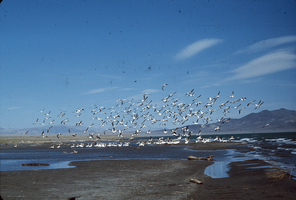
Slide of pelicans at Pyramid Lake, Nevada, circa 1970s
Date
Archival Collection
Description
Image
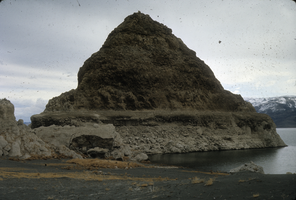
Slide of a tufa deposit in Pyramid Lake, Nevada, circa 1970s
Date
Archival Collection
Description
Image
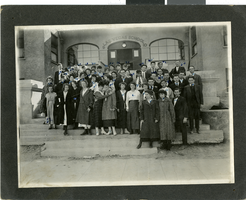
Photograph of students at Las Vegas School, Las Vegas (Nev.), 1916
Date
Archival Collection
Description
Image
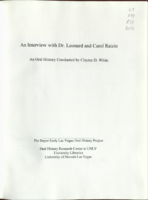
Transcript of interview with Dr. Leonard and Carol Raizen by Claytee D. White, April 8, 2009
Date
Archival Collection
Description
Leonard Raizin was born in Windsor, Ontario, Canada in 1930. His father was a cattle dealer. At an early age Raizin knew he wanted to be a doctor and after attending medical school he married his wife Carol Raizin born in Toronto, Canada. Leonard Raizin attended the University of Toronto for medical school in 1948. He met his wife Carol on a blind date. He started his internship at Sinai Hospital of Detroit in 1954. After a trip to Arizona and a feel of the desert weather the Raizins' with their four young daughters moved to Las Vegas, NV in 1961. When arriving in Las Vegas Dr. Raizin practiced at Southern Nevada Memorial Hospital (currently University Medical Center) and also at Sunrise as an anesthesiologist. There was a time while practicing in Las Vegas Dr. Raizin was the only anesthesiologist in the area, and experienced for the first 6 months of life in Las Vegas an extremely immersed schedule that never allowed him an entire night at home. Carol Raizin graduated as one of the first students at UNLV with a degree in Psychology in 1973. Carol eventually worked alongside her husband in their office handling bookkeeping for eight anesthesiologists. Dr. Leonard Raizin and Carol Raizin after a very successful life in Las Vegas are now retired. They still have a home in the Las Vegas area, however they spend their winters skiing in Park City, Utah and their summers fishing in Idaho.
Text

